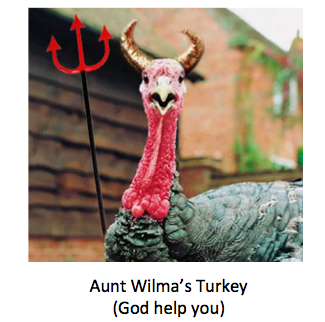
Many years ago, my large family would traditionally gather in Connecticut to enjoy each other's company on Thanksgiving. By today's standards, it was a risky trip getting there. Few of us wore seat belts. People smoked in cars that were run by leaded gasoline. No one had even heard of a breathalyzer; drunken driving was considered to be a hobby. And if you got into trouble on the road, you were hosed, because there was no such thing as 911 or a cell phone to call it.
Somehow, we always made the trip in one piece. But the real danger didn't start until dinnertime: Aunt Wilma's turkey.

Photo: Heavy.com
Lovely woman, but unfortunately, the era during which women finally got out of the kitchen didn't start quite soon enough for the health and wellbeing of our microbiomes. Black Friday didn't exist yet; Instead we celebrated Salmonella Sunday. She got me more than once (1). And since we're a science site, it isn't even all that unlikely, given advances in DNA sequencing, that if samples had been collected and preserved from Aunt Wilma's kitchen, that the ancestors of multiple strains of today's scourge—antibiotic resistant bacteria—could be traced precisely to that spot.
Now there is another Thanksgiving threat that we should be cognizant of: exploding turkeys—a phenomenon that is largely due to the relatively new practice of turkey frying. Although probably not as deadly as Aunt Wilma's turkey, exploding turkeys, uh, pop up in the news at Thanksgiving time, for example, a recent article in Consumer Affairs, and another in Popular Science, with the subtle title "How to deep-fry a turkey without killing yourself."
The problem is water, either on the outside of the turkey or in the whole bird if it is not properly thawed out and dried. When dropped into 350 degree oil, the water boils so quickly that is actually explodes, creating a deadly splatter of oil that can burn flesh or ignite fires. The National Fire Prevention Association says that there are three-times as many cooking fires on Thanksgiving as on other days.
The American Chemical Society just released a video that shows the do's and don'ts of turkey frying. I suggest that you watch it should you be inclined to give this a try.
It is difficult to compare the magnitude of damage that this newer technique might have contributed our to family's suffering, since Wilma's turkey tended to explode inside our stomachs, not outside them. But, at least to her credit, she never once burned up the house. Just the yams.
Have a happy Thanksgiving. Same to my Connecticut cousins, despite the fact that they will never speak to me again if they read this.
(1) Aunt Wilma's assault upon gastronomy was not confined to turkey. I think the string bean casserole got me another time. Whatever it was, it was green, but so was much of the meat, so I don't really know.
